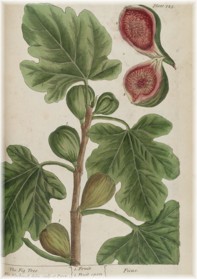Give a Fig
By Audrey Stallsmith

Oh, bring us a figgy pudding;
Oh, bring us a figgy pudding;
Oh, bring us a figgy pudding and a cup of good cheer.
We won't go until we get some;
We won't go until we get some;
We won't go until we get some, so bring some out here.
from "We Wish You a Merry Christmas"
Figs have been with us, quite literally, forever. Genesis 3:7 reports of Adam and Eve that "the eyes of them both were opened, and they knew that they were naked; and they sewed fig leaves together, and made themselves aprons." So the tree came in handy from the beginning, though not in quite the way that had been intended!
The fruits of Ficus carica, however, did become and still remain an essential in Biblical lands as well as much of the rest of the world. In Jotham's parable (Judges 9:8-14) the fig tree was even the other trees' second choice--after the olive--to rule over them.
Although California is the second leading producer of figs, behind Turkey, I'm afraid we Americans still tend to think of the fruits as a rare delicacy. We also frequently associate them with Christmas, because of the reference to figgy pudding in a famous carol.
That dessert was probably originally a steamed suet pudding laced with spices. Suet has a musky flavor not too popular with modern palates, however, although the pudding made from it is actually quite good. Provided that you serve it hot and ladle a sweet sauce liberally over the top! But suet does tend to harden when cold. So many modern recipes call for butter instead.
Although relatively small--since it only grows to about 20 feet--the fig tree, with its lobed leaves and purple or yellow pear-shaped fruit, is quite attractive. Perhaps that's what led to the term "full fig" being applied to anyone in elaborate dress, and "fine fig" being used to describe excellent physical condition.
The tree is also unusual in that it generally produces at least two crops, which is probably what causes it to stand for "prolific" in the Language of Flowers. The first of those crops appears on old wood before the leaves sprout.
That explains the baffling incident in the Gospels where Christ curses a barren fig tree. Even though the tree had apparently leafed out early, the very appearance of leaves indicated that it should have had fruit on it. So that fig might have been considered the ultimate hypocrite, being all show!
Another oddity about Ficus carica is that, according to the California fig advisory board, the "fruit" is actually "a flower that is inverted into itself." The blossoms appear in the interior and "the seeds are drupes, the real fruit." This, as you may imagine, causes some problems with pollination!
Fortunately, common figs don't require it, since they can produce hollow seeds anyway. Those, like the Smyrna type, however, need caprification. In this process wild figs, known as caprifigs, are placed in cultivated trees. The caprifigs contain wasps that carry pollen through small orifices in the fruits from the wild ones to the tame ones.
In ancient times, figs were considered the ultimate health food. According to Pliny, "They increase the strength of young people, preserve the elderly in better health, and make them look younger with fewer wrinkles." The fruits were also the favorite training food of gladiators and the original Olympic athletes. At one point, Greece went so far as to forbid any exportation of the fruit. So the word "sycophant" ("informer") actually derives from the Greek "to show the fig."
The price of a single fruit was probably negligible, however, since fig has frequently been used in slang expressions to indicate "a trivial or contemptible amount." ("I don't give a fig, I don't care a fig," etc.) Maybe that's why the fruit itself stands for "argument" in the Language of Flowers.
Although about half dextrose (a form of sugar) figs are also high in fiber and antioxidants. A mild laxative, the fruits, roasted, have also been used as poultices to draw out the infection from abscesses, boils, carbuncles, etc. ("For Isaiah had said, Let them take a lump of figs, and lay it for a plaister upon the boil, and he shall recover." Isaiah 38:21.) They also contain a sulphur, ficin, which soothes swollen joints and an anti-cancer element called benzaldehyde. The acrid white juice of the tree supposedly burns off warts as well.
Modern herbalists recommend a syrup made from cooked figs to soothe sore throats and coughs. Jethro Kloss reported that fig leaves boiled in Crisco "make an excellent ointment." He also prescribed a tea made from the leaves to remove age spots and bruises.
Fortunately, there are plenty of more pleasant reasons to savor the sweet taste of figs. You could make your own Fig Newtons, for example. Or, this year, when those carolers sing, "Bring us a figgy pudding," why not take them seriously?
Ficus carica image is from Herbarium Blackwellianum by Elizabeth Blackwell, courtesy of the Missouri Botanical Garden Library.








